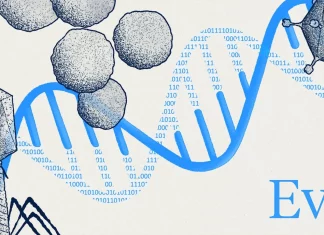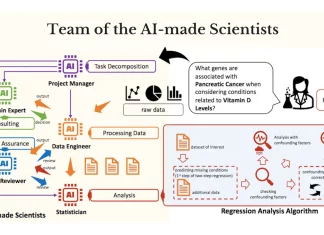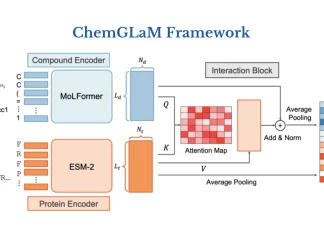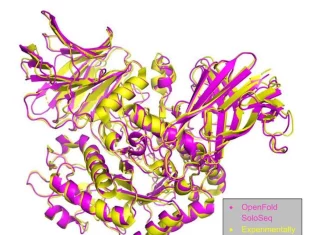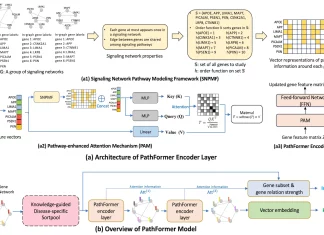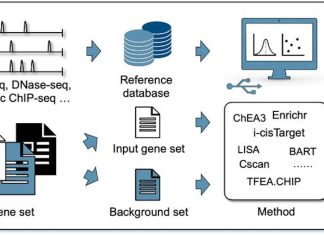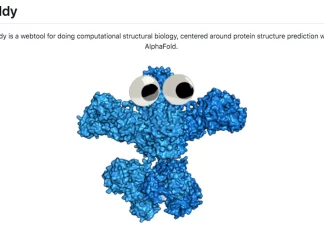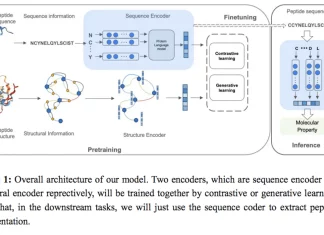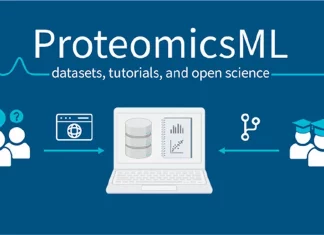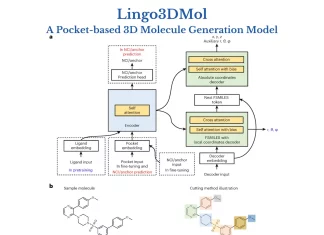Can AI Assistants Crack Bioinformatics Challenges? A New Study Explores the...
The scientific community may uncover the nature of life due to the great amount of biological data at its disposal. Implementing bioinformatics ensures converting...
From Molecules to Genomes: Evo’s Trailblazing Approach to Sequence Modeling and...
The DNA, RNA, and proteins that control an organism's entire functioning are all fully encoded in a sequence called the genome. Large-scale genome databases...
PocketGen: A Novel Deep Generative Model for Designing Protein Binding Sites
The ability to accurately model and redesign ligand binding sites (pockets) on protein surfaces holds tremendous value across fields like drug discovery, enzyme engineering,...
Meet OncoGPT: Can This Medical Language Model Improve Communication and Support...
OncoGPT is a customized language model created by Shenzhen Kanghua Juntai Biotech Co. Ltd. researchers in China that is intended to deliver precise medical...
AlphaFLOW and ESMFLOW: A New Approach to Modeling Protein Ensembles with...
Dynamic structural ensembles play a major role in the biological functions of proteins. For the purpose of learning and sampling the conformational landscapes of...
Unlock the Potential of DeepMod2: A Deep Learning Framework for Precise...
Reduced representation methylation sequencing for CpG islands or imprinted areas is made possible by Oxford Nanopore sequencing, which offers a distinct advantage over other...
Team of AI-made Scientists: A Groundbreaking System for Automating Scientific Discovery
Scientists from the University of Illinois, in collaboration with experts in the field, have unveiled a cutting-edge system named the "Team of AI-made Scientists."...
LLMs in Biomedicine: Navigating the Future with the BioChatter Open-Source Solution
BioChatter, a new open-source framework developed by Heidelberg University researchers and collaborators, aims to harness the power of large language models (LLMs) for biomedical...
Unlocking New Frontiers in Drug Design with PCMol: Integrating AlphaFold and...
Deep learning-based virtual screening provides a more effective way to find molecules that resemble drugs, and virtual sources give chemists useful information. Leiden University...
Unveiling Flexiplex: A Versatile and Fast Demultiplexing and Sequence Searching Tool...
Omics datasets generated by high throughput sequencing contain vast amounts of nucleotide data that must be analyzed to extract meaningful biological insights. A common...
NIH’s All of Us Research Program Unveils 275 Million New Genetic...
The All of Us Research Program, with its ambitious objective of creating a diverse cohort of one million volunteers and making their data available...
Cracking the Code of Drug-Drug Interaction: DDIPrompt Unlocks a World of...
Adverse drug-drug interactions (DDIs) pose a major health risk when using drug combinations to treat complex diseases. However, predicting harmful DDIs is extremely challenging...
AlphaFind: A New Frontier in Proteomic Exploration
Effective structure-based search tools are necessary to efficiently organize the massive volume of data in the database. Novel tools like FoldSeek and 3D-surfer have...
Improving Patient Care: The Role of Large Language Models in Doctors’...
The digitization of health records has enabled powerful AI techniques to extract key medical insights from the vast trove of unstructured clinical notes. However,...
Revolutionizing Drug Discovery with ChemGLaM: Chemical-Genomics Language Models for Compound-Protein Interaction...
Compound-protein interaction (CPI) prediction accuracy is crucial for drug discovery. Creating deep learning models that can be applied broadly requires expanding the CPI data...
OpenFold Unveils SoloSeq and OpenFold-Multimer: Advancing AI in Protein Structure Analysis
OpenFold, an artificial intelligence (AI) research consortium, has announced the release of two new tools that aim to improve protein structure prediction: SoloSeq and...
Accelerating Cancer Research: MuSiCal Offers Accurate and Sensitive Mutational Signature Analysis
Cancer is a complex disease. It is brought on by the accumulation of several gene alterations. Understanding the patterns of these alterations, or mutational...
Unveiling DeepGO-SE: Advancing Protein Function Prediction Leveraging Language Models and GO...
Gene Ontology is an axiomatic theory that describes the molecular roles, biological processes, and cellular placements of proteins using more than 100,000 axioms. Learning...
Meet DNABERT-S: Illuminating Genomic Diversity through Species-Aware DNA Embeddings
For scientists studying the functions of the genome, DNA embedding is a vital tool. Effective investigations like species categorization and metagenomics binning are made...
A Novel GNN Model ‘PathFormer’ Revolutionizes Highly Accurate Disease Diagnosis and...
When analyzing omics data, regression analysis is an essential tool for identifying biomarkers. For the analysis of graph-structured data, graph neural networks (GNNs) are...
University of Michigan Researchers Discover Novel Plant Protein Fold with Potential...
Researchers from the University of Michigan have reported the discovery of a new plant protein fold that catalyzes the formation of macrocyclic peptides through...
Meet Proteus: Transforming the Landscape of Protein Design with Innovation and...
Proteins perform essential functions in living organisms and adopt specific three-dimensional structures dictated by their amino acid sequences. The ability to accurately design novel...
DANCE Unveils Hidden Depths of Protein Movement, Paving the Way for...
One must understand proteins' structural flexibility in-depth to comprehend their role in biological processes and functional systems. It is still challenging to predict various...
Beyond One-Size-Fits-All: Moffitt Unveils First Individualized Predictive Model for the Treatment...
Patients with recently diagnosed non-differentiated multiple myeloma (NDMM) have a wide range of outcomes, with overall survival (OS) spanning from several months to more...
Unlocking the Potential of RNA Design with Generative AI using GenerRNA
A team of researchers from the University of Tokyo developed GenerRNA, the first large-scale pre-trained AI model for automated RNA design that does not...
GPCR-BERT: Revolutionizing GPCR Research with Protein Language Models
Recent advances in large language models (LLMs) and transformers have opened new possibilities for modeling protein sequences as language. Carnegie Mellon University researchers have...
tFold Unveiled: A Swift and Accurate Approach to Antibody-Antigen Complex Modeling...
The soldiers of our immune system, antibodies, bind to specific targets like viruses and toxins and neutralize them. Predicting antibody-antigen complex structures accurately has...
Choosing the Best Tool for Identifying Transcriptional Regulators: Navigating the NGS...
This article delves into a recent study undertaken by a team of researchers that examined multiple computer algorithms for transcriptional regulator prediction using Next-Generation...
Unveiling the Power of Deep Learning: A Comprehensive Benchmark of Tertiary...
Before understanding RNA biology, one must grasp the three-dimensional structure of RNA. Because experimental procedures require a lot of labor and money, computer approaches...
Making AI-Driven Structural Biology Accessible with Foldy
Recent breakthroughs in AI-based protein structure prediction have enormous potential to accelerate discoveries across the life sciences. However, major barriers persist in making these...
MarkerGeneBERT: Revolutionizing Cell Marker Extraction Utilizing Natural Language Processing
MarkerGeneBERT, a natural language processing (NLP) system to automatically extract cell type markers from single-cell sequencing literature by parsing full text, was recently introduced...
CombFold: Advancing Structure Prediction of Large Protein Assemblies with Combinatorial Algorithms...
Deep learning models like RosettaFold and AlphaFold2 can predict protein structure with high accuracy; however, they still have difficulties when it comes to intricate...
Unleashing nanoBERT: Revolutionizing Nanobody Therapeutics with Deep Learning
Scientists from the University of Southern Denmark, NaturalAntibody and Alector Therapeutics unveil nanoBERT, a nanobody-specific transformer designed to predict amino acids in specific positions...
UChicago Scientists Crack the Code of HIV Entry into the Nucleus...
In a major scientific breakthrough, researchers at the University of Chicago have succeeded in creating a comprehensive model of the nuclear pore complex with...
reguloGPT Unleashed: GPT-Powered Knowledge Graphs Illuminate Molecular Regulatory Pathways
Understanding biological processes and offering organized representations of intricate relationships are made possible by Knowledge Graphs, or KGs. However, the resources available today to...
Has ESM-2 Truly Learned the Language of Protein Folding?
Protein structure prediction and design may be accomplished using protein language models (pLMs). They may not completely comprehend the biophysics of protein structures, though....
Revolutionize RNA Structure Prediction with RNA3DB: The Pinnacle Dataset for Training...
Harvard University researchers introduce RNA3DB, a dataset crafted from the Protein Data Bank (PDB), addressing challenges in RNA structure prediction. In response to limitations...
Revolutionizing Protein-protein Interaction Prediction with LazyAF: A Breakthrough Pipeline for Medium-scale...
Predicting protein structures has been transformed by artificial intelligence. However, rather than competence, accessibility, and ease of use are increasingly becoming limiting issues for...
Unlocking the Enhancer Code: Deep Learning’s Role in Designing Cell-specific Genetic...
Transcriptional enhancers control the spatiotemporal activation of the target genes they regulate by serving as docking stations for various transcription factor combinations. It has...
Probing Ancestral Genomes Uncovers Unannotated Degenerate Transposable Elements Contributing to Gene...
Transposable elements (TEs) supply genomes with both coding and non-coding sequences and have significant roles in evolution. However, the extent of TE annotations in...
Meet IntegrAO: A Novel Unsupervised Framework for Integrating Incomplete Multi-omics Data...
Advances in high-throughput omics profiling have improved cancer patient classification significantly. However, insufficient data in multi-omics integration is a big problem because conventional techniques...
Unlocking Cellular Mysteries with scPerturb: A Deep Dive into Harmonized Single-cell...
Molecular and phenotypic responses to numerous perturbations are revealed by the increasing number of single-cell perturbation studies. However, variations in format, naming conventions, and...
PepHarmony: An Integrated Sequence and Structure-based Peptide Encoding Framework Employing Multi-view...
Gaining insight into the relationship of the Peptide sequence (the amino acid sequence) and their structure (the way they fold and interact) is a...
Empowering Researchers with ProteomicsML: An Online Oasis of Data Sets and...
The laborious aspects of acquiring and curating data sets for machine learning, especially in proteomics-based systems, present unique difficulties because there is a significant...
The Human Immunome Project: Mapping the Global Landscape of Immune Diversity...
In a landmark initiative, the Human Immunome Project (HIP) commenced at a summit in La Jolla, California, bringing immunology specialists together to address the...
Unveiling ProtHyena: A Fast and Efficient Protein Language Model for Analysis...
The field of biological sequence analysis has lately benefited from the revolutionary changes brought about by the development of self-supervised deep language models for...
IntelliGenes Unveiled: A New Paradigm for AI-Driven Biomarker Discovery from Multi-genomic...
IntelliGenes is a new machine learning pipeline developed by researchers at The State University of New Jersey that integrates multi-genomics, clinical, and demographic data...
Meet Lingo3DMol: A Pocket-based 3D Molecule Generation Method Leveraging Language Models...
The drug development process involves a winding trail across the enormous chemical wilderness, looking for compounds that interact ideally with their target proteins. Traditional...
Unveiling the Future of Protein Design: RFdiffusion’s De Novo Revolution
Protein design has seen significant progress, but a comprehensive deep-learning framework for protein design, including de novo binder design and higher-order symmetric architectures, remains...
Cleveland Clinic and IBM’s Blueprint for Discovering Novel Immunotherapy Targets Using...
Predicting the immunogenicity of peptide antigens attached to major histocompatibility complex (MHC) molecules is critical for developing new immunotherapies and better understanding human immune...


